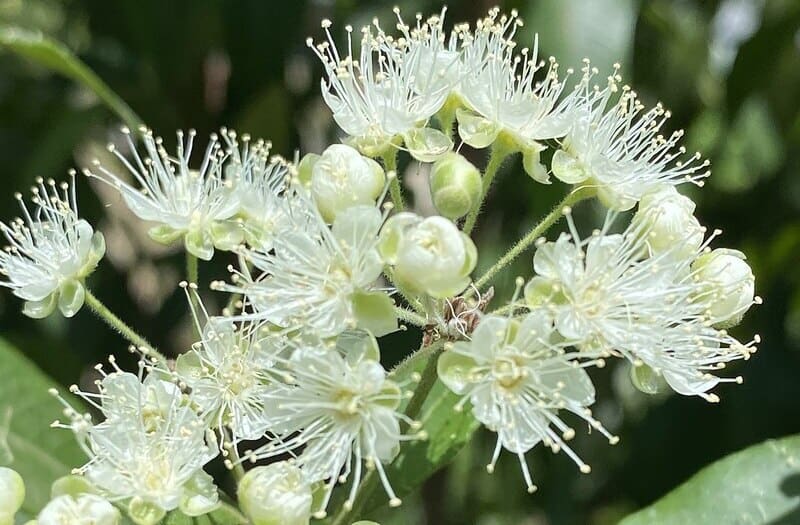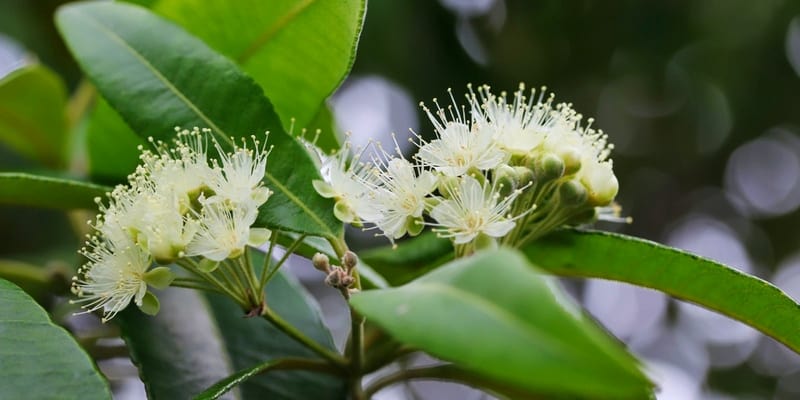Lemon is a heavenly, relaxing scent, citrusy and sweet. If you’ve ever wanted your whole garden smelling of lemon – or even just your home – then the lemon myrtle is an excellent tree to grow.
When crushed, each fresh leaf releases a gorgeous scent. In summer, it produces pretty clusters of cream flowers.
Growing lemon myrtle is fairly straightforward. In an outdoor habitat, it can reach up to 20m, although in more southern regions it will only grow as a large shrub up to 4-6m. Indoors, you can grow it in a pot with regular pruning. Plant lemon myrtle in well-drained and slightly acidic soil, and place it somewhere in full sun to partial shade. It’s better propagated from cuttings. Lemon myrtle trees have relatively few pests and diseases, but can suffer from myrtle rust.
Whether you want some delicious lemon myrtle infusion or just desire that exquisite aroma in the air, here’s how to grow lemon myrtle at your home – and how to make the most out of it, too!
About The Lemon Myrtle

The lemon myrtle (backhousia citriodora) is also called a sweet verbena tree or a lemon-scented myrtle. It’s a rainforest tree native to subtropical Queensland.
The lemon myrtle has dark green leaves, with white flower bunches in the summer. In cultivation, lemon myrtle trees can reach a height of about 8m.
Two close relatives of the lemon myrtle are the cinnamon myrtle (backhousia myrtifolia), which has a more cinnamon-like scent and taste; and aniseed myrtle (backhousia anisata), which can be used in place of star anise or fennel.
The lemon myrtle tree is huge in the Australian native foods industry, with plenty of businesses producing products from its leaves and twigs.
It’s also a giant in the cosmetics industry. It’s prized for its high citral content – 98%, as opposed to lemongrass (75%) and verbena (74%). But it’s also great as an ornamental tree in a home garden!
Lemon Myrtle Growing Conditions

Climate
Lemon myrtle is an Australian native tree, and grows best in subtropical climates. It’s mostly native to Queensland, but can grow in South Australia or Western Australia as a shrub.
Avoid areas that experience frost, as young trees will not tolerate overly cold conditions.
Soil
Plant lemon myrtle in slightly acidic, well drained soil enriched with plenty of organic matter.
Keep the soil moist while it’s still young, but established trees can tolerate drought.
Sun
This feature tree will grow best in full sun, but can still thrive in part shade.
How To Grow Lemon Myrtle

Growing lemon myrtle trees
There are two ways to grow lemon myrtle at home: germinating from seeds, or striking from cuttings.
How long does lemon myrtle take to grow? About 3-4 years on average – so be patient!
From seed
Lemon myrtle seeds have low germination rates, but it’s still possible to grow them!
Soak seeds overnight, then sow in trays with a seed-raising mix. Lightly cover with mix – lightly.
Place somewhere warm and sunny, and mist regularly to keep the seed mix moist. Germination takes about 2-8 weeks.
From cuttings
Cut a few stems off the main plant, making sure to leave several leaf nodes on your cutting. Strip the foliage off the base, at least 3cm up.
Place the stems in a small pot with a mix of coarse sand and potting mix. Water well, then set somewhere warm and sunny.
Growing lemon myrtle in a pot
Growing potted lemon myrtle is similar to growing it outdoors.
Simply repot as the plant’s root ball starts outgrowing its container, and prune regularly to maintain a compact shape.
The plant will still grow fairly large, so ensure you have a suitably-sized container to house it!
Lemon Myrtle Care

Myrtle rust
This is a fungal disease that attacks new growths in young plants. Myrtle rust is recognisable by the dark purple spots on leaves, which eventually develop yellow, powdery spores.
Launder all clothing and gloves worn when handling affected plants before proceeding to other areas.
You can contact your local garden centre or gardening service for approved anti-fungal or chemical treatments.
Watering
New shrubs and trees should not be allowed to dry out, so water regularly to keep the soil moist.
They’re more drought tolerant when mature, but water deeply during hot and dry weather.
Pruning
You can trim a lemon myrtle at any time of year when outdoors, as it has a low branching habit.
As a shrub, screening hedge, or potted plant, it will require more regular pruning.
If you’re uncertain about doing it yourself, hire a garden maintenance service to help maintain your lemon myrtle – and all your other plants!
Fertiliser
Enrich the soil with organic mulch or compost before planting to encourage better plant growth.
When the plant is established, you can feed it organic slow-release fertiliser so as not to overwhelm the plant with excess nutrients.
Since lemon myrtle isn’t a Proteid plant, all-purpose fertiliser will work, but you can switch to a low-phosphorus fertiliser if preferred.
Lemon Myrtle Uses

Lemon myrtle tea
Steeping lemon myrtle leaves in water creates an excellent herbal infusion or tea. Drink it hot or cold, sweetened to taste.
Lemon myrtle tea is calming, and is high in antioxidants and vitamins C and E. It can also help boost your immune system.
Cosmetics
Lemon myrtle essential oil or citral oil is used in plenty of cosmetics to add a lemon scent. Also known as lemon-scented verbena, the oil is distilled from leaves and twigs of the Australian lemon myrtle.
The high citral content of lemon myrtle gives its essential oil plenty of beneficial properties – it’s anti-inflammatory, antibacterial, and antiseptic. This makes it popular for cremes, soaps, and serums.
Culinary aromatics
The lemon myrtle leaf has many uses in the kitchen. Use fresh leaves as aromatics the way you would bay leaves, and add them fresh or dry in any dish.
You can infuse dried leaves in olive oil to add more flavour. Lemon myrtle leaf can replace lemongrass in different recipes such as curries, pastas, sauces, and even syrups.
The aboriginal use for lemon myrtle involves wrapping fish and lemon myrtle leaves in bark to cook.
Lemon myrtle can also be infused into cakes and other pastries for a zesty-flavoured dessert.
Medical uses
Indigenous Australians crush lemon myrtle leaves and inhale the scent to treat headaches. Lemon myrtle oil is a natural antiseptic, while you can also steep leaves in water and use them as a wash.
Meanwhile, lemon myrtle infusions are antimicrobial and antiviral, and help reduce inflammation. Drink lemon myrtle tea when you have a cold or are suffering from mild pain.
There are as many uses for a lemon myrtle tree as there are reasons to plant one. It’s one of many excellent Australian native trees to grow, especially when that lemon scent fills the air after the rain.
It’s also the perfect excuse to crush up some fresh leaves and try out a new dessert – and these trees grow big, so pick as many as you want!

